A Study of Elemental Abundance Pattern of the r-II Star HD 222925
Fang Wen, Wan-Qiang Han, Wen-Yuan Cui, Hong-Jie Li, and Bo Zhang
1 College of Physics, Hebei Normal University, Shijiazhuang 050024, China; wenyuancui@126.com, cuiwenyuan@hebtu.edu.cn, zhangbo@hebtu.edu.cn 2 Department of Physics, Shijiazhuang University, Shijiazhuang 050035, China 3 School of Sciences, Hebei University of Science and Technology, Shijiazhuang 050018, China Received 2023 April 22; revised 2023 June 22; accepted 2023 July 11; published 2023 October 31
Abstract HD 222925 is a rare r-process enhanced star in the Milky Way because of its metal abundance ([Fe/H]=−1.46±0.10) and Eu abundance ([Eu/Fe]=1.32±0.08).Based on the very complete set of elemental abundances of HD 222925, we use the abundance decomposition method to fit the observed abundances of 58 elements in the sample star,which is also the largest number of elemental abundances fitted at the same time for a fixed star.We analyze the astrophysical origins of elements in HD 222925 by its abundance ratios and component ratios.It is found that the light elements and the iron group elements in HD 222925 mainly originate from the primary process of the Type II supernovae(SNe II)with the progenitor mass M>10 M⊙and have no contribution from SNe Ia and the first generation of very massive stars.The contribution of the weak r-process to Ga,Ge,and As is superior to that of the other processes,and its contribution decreases linearly with increasing atomic number.The main r-process that is likely derived from a neutron star merger plays a key role in the formation of neutroncapture elements (Z ≥38) in HD 222925.
Key words: stars: chemically peculiar – stars: individual (HD 222925) – nuclear reactions – nucleosynthesis –abundances – stars: abundances
1.Introduction
The slow (s-) and the rapid (r-) neutron-capture process are thought to be the main mechanisms to produce elements heavier than iron.The r-process can be divided into two categories: the weak r- and the main r-processes.Only light neutron-capture elements can be created by the weak r-process that may happen in Type II supernovae (SNe II) with a progenitor mass M>10, while both light and heavy neutron-capture elements can be created by the main r-process.Possible astrophysical sites of the main r-process that have been suggested are core-collapse supernovae (Buridge &Burbidge 1957; MacFadyen & Woosley 1999; Winteler et al.2012; Nishimura et al.2015; Mösta et al.2018; Fraser &Schönrich 2022) and binary neutron star mergers (NSMs)(Freiburghaus et al.1999; Goriely 2012; Abbott et al.2017;Watson et al.2019;Dvorkin et al.2021),which is still an open question.
The r-process enhanced stars provide important information about the nature of the r-process, which can help us to further understand the r-process and explore its astrophysical sites.According to the values of [Eu/Fe], the r-process enhanced stars can be classified into two groups: the r-I stars with 0.3 ≤[Eu/Fe]≤1.0 and the r-II stars with [Eu/Fe]>1.0(Beers & Christlieb 2005).The abundance patterns of heavy elements with Z>56 of both r-I and r-II stars are in good agreement with the scaled solar r-process pattern, so the rprocess is a universal nucleosynthesis way (Ivans et al.2006;Burris et al.2000; Frebel et al.2007).
A pure r-process signature can only be shown in the r-II stars that are not or least affected by the s-process (Frebel 2010).Most of the known r-II stars usually have very low metallicities with [Fe/H]<−2.5 (Sneden et al.1996; Cayrel et al.2001;Barklem et al.2005;Hayek et al.2009; Li et al.2015; Ji et al.2016), while the moderately metal-poor r-II stars(−2<[Fe/H]<−1) are rare.Only three r-II stars with −2<[Fe/H]<−1 have been discovered in the Milky Way so far,HD 222925([Fe/H]=−1.46, [Eu/Fe]=1.32), J1802-4404([Fe/H]=−1.55, [Eu/Fe]=1.05) and 2MASS 18174532-3353235 ([Fe/H]=−1.67, [Eu/Fe]=0.99)(Roederer et al.2018, 2022; Hansen et al.2018; Johnson et al.2013).HD 222925 and J1802-4404 are halo stars, while 2MASS 18174532-3353235 is a bulge star.In addition, the moderately metal-poor r-II stars are also found in some dwarf galaxies.Shetrone et al.(2001)discovered two r-II stars in the Ursa Minor dwarf spheroidal galaxy.One of the two stars, cos 82,has[Fe/H]=−1.42 and[Eu/Fe]=1.49(Aoki et al.2007),it is similar to HD 222925.Ji et al.(2016) identified a r-II star of relatively high-metallicity([Fe/H]∼−2), J033457-540531 with extremely high r-process elemental abundances of[Eu/Fe]∼1.7 when studying the nine brightest known red giants (−3.5<[Fe/H]<−2) in the ultra-faint dwarf galaxy Reticulum II.Considering the moderately metal-poor r-II stars(−2<[Fe/H]<−1) having higher metallicities than the other known r-II stars, they are very valuable for a comprehensive understanding of the main r-process.
HD 222925 has the highest abundance of Eu ([Eu/H]=−0.14)among all r-process enhanced stars known in the Milky Way(Roederer et al.2018,2022),so it attracts more attention.Roederer et al.(2018, 2022) determined the abundances of 63 elements in HD 222925 based on the high-resolution optical spectra and ultraviolet (UV) spectra.This abundance set is the most complete for any object beyond the solar system.Investigating the astrophysical origins of the elements in HD 222925 using this abundance set can help us understand the formation of the sample star.
Navarrete et al.(2015) suggested that the enriched Ba in HD 222925 was likely to come from an unseen companion by the mass transfer, which has passed through the asymptotic giant branch(AGB)phase.This means that HD 222925 should have the s-process characteristic.However,they did not further verify this.Roederer et al.(2018) pointed out that HD 222925 has no companion by monitoring its radial velocity.Moreover,they suggested that HD 222925 was not affected by the sprocess by comparing the matching degree between the abundances of elements(Z ≥38) in HD 222925 and the scaled solar r-process residuals.However,the solar r-process residuals are not a direct result, and it is obtained by subtracting the sprocess contribution from the total abundances of the solar system.In this work, we further illustrate the absence of sprocess characteristics in HD 222925 based on the observed abundances of the sample star and the multiple components model.
In addition, Roederer et al.(2018) concluded that the progenitor system may be similar to the remaining population of ultra-faint dwarf galaxies if the r-process material in HD 222925 was derived from a single, high-yield r-process event, which might be a neutron star merger.A detailed discussion is needed.
In this paper, how the observed abundances of HD 222925 used for this study were obtained is presented in Section 2.The multiple components model is used to fit the observed abundances of HD 222925 and to speculate the astrophysical origin of elements in Section 3.Using the calculation method from Yang et al.(2017), we analyze the formation of HD 222925 in Section 4.The conclusion is given at the end.
2.Acquisition of Observed Abundances of HD 222925
The sample star HD 222925 is a red horizontal-branch(RHB)field star identified by Gratton et al.(2000).The highresolution spectra of HD 222925 were obtained using the Magellan Inamori Kyocera Echelle spectrograph (MIKE) in 2018.The spectra were reduced with the CarPy MIKE reduction pipeline (Kelson et al.2000; Kelson 2003), and processed with the IRAF software by Roederer et al.(2018).Based on the high-resolution optical spectra of the sample star,Roederer et al.(2018)determined the stellar atmospheric parameters and the abundances of 46 elements(6 ≤Z ≤90)in HD 22925 using MOOG with LTE.They derived [Fe I/H]=−1.56 and[Fe II/H]=−1.47,and the metallicity of HD 222925 was identified as −1.47 when taking the NLTE correction (+0.07) for Fe I lines into account.The enhanced levels of Ba and Eu in HD 22925 were also determined:[Ba/Fe]=0.55±0.06 and [Eu/Fe]=1.33±0.08.In 2022, the high-quality ultraviolet(UV)spectroscopy of HD 222925 was obtained by the Space Telescope Imaging Spectrograph on the Hubble Space Telescope,which was coadded and normalized using the IRAF software(Roederer et al.2022).Adopting the same atmospheric model and stellar parameters as in Roederer et al.(2018), Roederer et al.2022 derived abundances for 45 elements in HD 222925 using the 404 absorption lines in the UV spectra.They included elements such as Ga, Ge, As, Se,Cd,In,Sn,Sb,Te,W,Re,Pt and Au,which were infrequently tracked in r-II stars and not measured in Roederer et al.(2018).By combining the abundance results from optical and UV lines, Roederer et al.(2022) recommended the most complete abundance collection for an extrasolar object,which included 63 elements in HD 222925.In this abundance collection, the abundances of elements with Z ≤30 from the optical spectra and UV spectra are consistent, while the abundances of other elements were critically estimated on a case-by-case basis (see Appendix A in Roederer et al.2022).
According to the recommended elemental abundances of HD 222925 in Roederer et al.(2022), we fit the abundance pattern of 58 elements.The two elements C and N are generally not studied in the multiple components model because in stars the element C may transform into the element N, while the elements P, S and K cannot be studied due to lack of primary component abundances.
3.The Astrophysical Origins of Elements in HD 222925
3.1.Model and Calculations
The chemical elements in stars usually come from the molecular clouds where they were born, and they can be produced through multiple mechanisms.In general, the formation of elements with Z<30 is related to SN explosions,and the neutron-capture elements are produced by the s- and/or r-process(Woosley&Weaver 1995;Travaglio et al.2004;Roederer et al.2010).To study the astrophysical origins of each element in HD 222925,we adopt the multiple components model to fit its observed abundances.The s-component abundances are taken from Bisterzo et al.(2010), here we adopt the 1.5 M⊙model at [Fe/H]=−2.0 with ST/12 (see their Table B6), since the calculated ratios [Pb/Ba]=0.06 is close to the observed ratio[Pb/Ba]=0.02,and the abundances are normalized to the main s-component of Ba abundance in the solar system.The r-component abundances of Ge, As, Se,W and Re are from Niu et al.(2014), Han et al.(2018),Arlandini et al.(1999).Based on the roughly linear relationship between the weak r-process contribution to the r-process abundances of the solar system and the atomic number(Li et al.2013), the component abundances of the two r-processes for the elements Ga,Cd,In,Sn,Sb,Te and Ta are estimated in this work.The r-component abundances of other elements are obtained from Li et al.2013.The multiple components model is represented as (Han et al.2020):
where Niis the abundance of the ith element.Ni,r,m,Ni,pri,Ni,s,m,Ni,secand Ni,Iarepresent the scaled component abundances of the main r-processes, primary process, main s-processes,secondary process and SNe Ia, respectively.The component abundances of the primary process contain the abundances of the primary light elements, iron group elements and weak rprocess elements.On the other hand, the component abundances of the secondary process contain the abundances of the secondary light elements, iron group elements and weak sprocess elements.Cr,m, Cpri, Cs,m, Csecand CIaare the corresponding coefficients.To determine the five coefficients in Equation (1), χ2is defined as:
where logNi,obsandare the observed abundance and error of the ith element,which are adopted from Roederer et al.(2022).logNi,calis the calculated abundance of the ith element,which can be determined by Equation (1).K and Kfreeare the number of elements studied and the number of free parameters,where K and Kfreeare equal to 58 and 5, respectively.
In the calculation, we obtain the minimum value of χ2is 1.71, and five component coefficients are Cr,m=21.3,Cpri=3.3, Cs,m=0.5,and CIa=0.Obviously,Cr,mis an order of magnitude larger than Cpriand two orders of magnitude larger than Cs,mand Csec,which suggests that the neutron capture elements in HD 222925 are mainly originated from the main r-process and the influence of the s-process on HD 222925 is almost negligible.The results indicate that the characteristics of HD 222925 are consistent with those of the r-II star.CIa=0 means that SNe Ia made no contribution to the element abundances of HD 222925.SNe Ia begins to contribute to the interstellar medium at [Fe/H]∼−1.0 in the Milky Way(Kobayashi et al.1998), while in dwarf galaxies the contributions of SNe Ia can start at [Fe/H] 《−1.0 (Cohen&Huang 2009;Letarte et al.2010;Tsujimoto 2011).Based on the metallicity and high [α/Fe](∼0.40) of HD 222925, we speculate that the contribution of SNe Ia should not have been present yet.
We add to Equation (1) the Prompt component, CPNi,P,which may arise from the first generation of very massive stars(Qian & Wasserburg 2001), and refit the observed abundance pattern of HD 222925.Due to the lack of Prompt component abundances for O and Cu, we have studied 56 elements in HD 222925.The calculated results show that Cr,m, Cpri, Cs,m,Csecand CIaare almost unchanged, and CPis zero.Using the same method to study CS 22892-052([Fe/H]=−3.10), the coefficients are Cr,m=50.44, Cpri=2.74 and Cp=0.21 (Li et al.2013).Comparing the coefficient Cpof HD 222925 with that of CS 22892-052, we can see that there is no Prompt component contribution to the abundances of HD 222925,which is consistent with the conclusion of Li et al.(2013),i.e.,the contribution of Prompt component would be invisible for higher metallicities.

In addition, we calculate the component abundances of the main r-, primary, main s- and secondary processes, respectively.The comparison between the component abundances and the observed abundances of HD 222925 is presented in Figure 2.


Figure 2.Comparisons between the component abundances of the main r-, primary, main s- and secondary processes and the observed abundances of HD 222925.
3.2.The Astrophysical Origins of Elements in HD 222925
In order to explore the astrophysical origin of elements in HD 222925, we determine the abundances ratios and components ratios of the sample star.The comparison between the observed abundances ratios, the calculated abundances ratios and components ratios of HD 222925 is presented in Figure 3.We can see that the contribution of the main s- and the secondary processes to the abundances of elements in HD 222925 is negligible.Further,it is clear in Figure 3 that the light and iron group elements are only associated with the primary process, while the heavy neutron-capture elements(Z>56) are dominated by the main r-process.It indicates that the astrophysical sites where the light elements and iron group elements are produced are different from the ones where the main r-process.
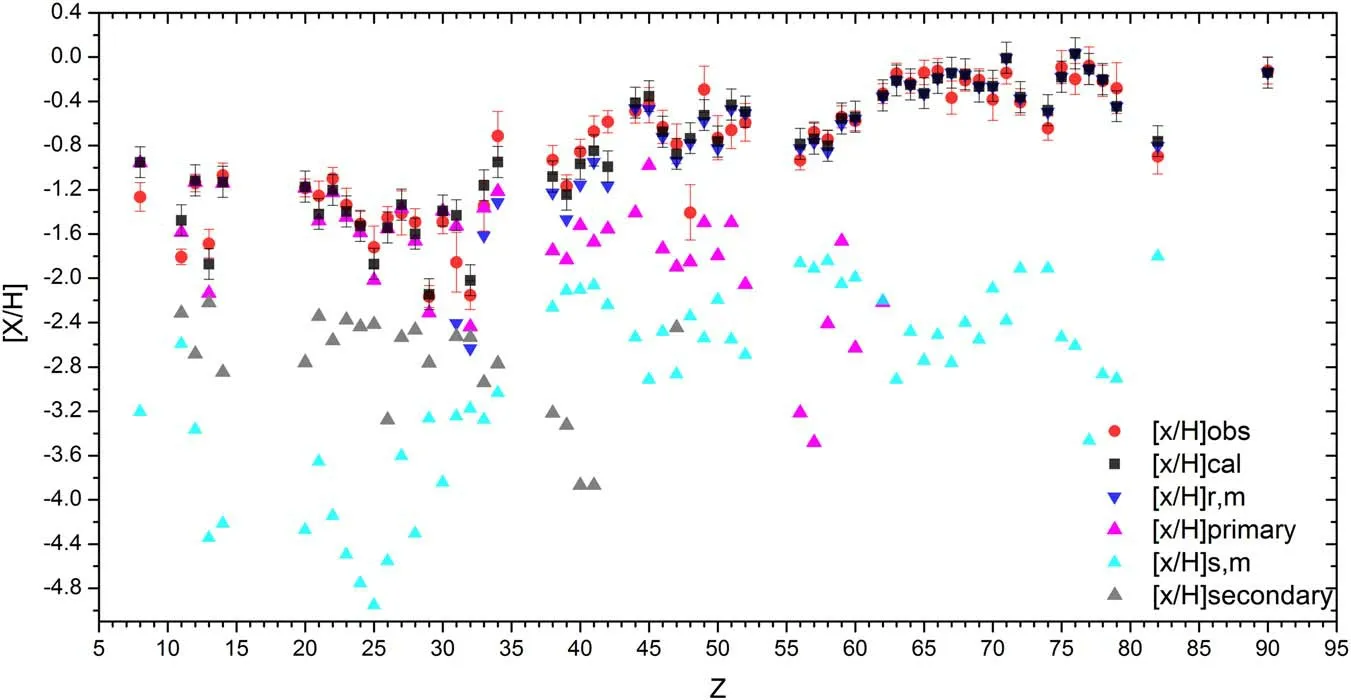
Figure 3.The observed abundances ratios,the calculated abundances ratios and components ratios of HD 222925.The components ratios include the ratios of main r-,primary, main s- and secondary components, respectively.
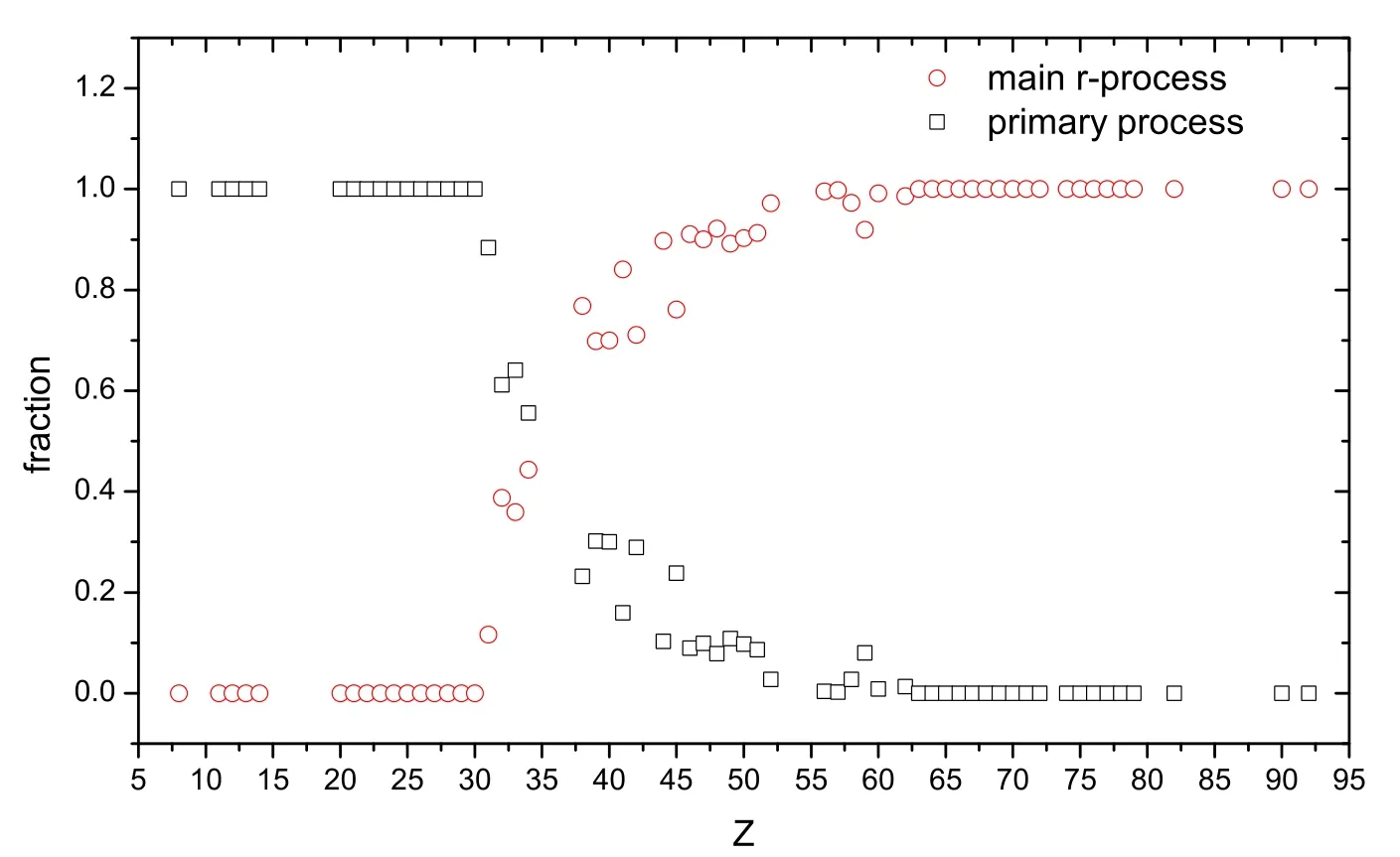
Figure 4.The relative contribution ratios of main r-and primary processes to elements in HD 222925.The black open rectangles are the ratios of the primary process contribution to elements and the contribution ratios of the main r-process are shown as red circles.
From Figure 3, we can find that the weak r-process contributes to both the light neutron-capture elements (31 ≤Z ≤52)and some of the heavy neutron-capture elements(56 ≤Z ≤62), but its contribution to the heavy neutron-capture elements is negligible.The relative contribution ratios of the main r-process to neutron capture elements are calculated as:
where the meaning of Ni,r,m,Ni,pri,Cr,mand Cpriis the same as in Equation (1), and the values of Cr,mand Cpriare 21.3 and 3.3.The calculated results are shown in Figure 4.
As can be seen in Figure 4, the main r-process does not contribute to the light elements and iron group elements in HD 222925.The contribution ratios of weak r-process to light neutron capture elements, e.g., Ga, Ge, As and Se, are very high and they are 0.88, 0.61, 0.64 and 0.56, respectively.Niu et al.(2014)suggested that the r-process is not the only way to produce Ge in the solar system and Ge can also be generated by the weak s-process,which can be found in Figure 3.According to the results in Section 3.1, the contribution ratio of the weak r-process to the element Ge in HD 222925 is about 0.41,while 33% of Ge is produced by the weak s-process.From Figure 3,we speculate that a similar situation is likely to occur with the element Ga.The ratio of the contribution to Ga of the weak rand weak s- processes are 0.81 and 0.08.In addition, we can also see in Figure 4 that the contribution ratios of weak rprocess to Sr, Y, Zr, Mo and Rh are in the range of 0.23-0.30,while the ratios of contribution to Nb, Ru, Pd, Ag, Cd, In, Sn and Sb are around 0.10.The contribution of the main r-process is dominant in the neutron-capture elements (Z ≥38).
3.3.Uncertainties of Component Coefficients of HD 222925

4.Analysis on the Formation of HD 222925
There is one r-II star in the UMi dwarf system,COS 82([Fe/H]=−1.42, [Eu/H]=−0.18), whose metallicity and Eu abundance are similar to those of HD 222925.However, the ratio of α-elements to Fe in HD 222925 is about 0.40, while this ratio in COS 82 is about 0.04 (Aoki et al.2007).The difference in the ratio of α-elements to Fe suggests that HD 222925 and COS 82 have different histories of elemental enrichment.The lower abundances of α-elements in COS 82 should be caused by the contamination with SNe Ia.There is a longer chemical enrichment timescale in dwarf galaxies,so the high Eu abundance of COS 82 may be due to the influence of multiple r-process events (Tsujimoto et al.2017).From the previous calculations(see Section 3), we suggest that the light elements and iron group elements in HD 222925 come from SNe II with a progenitor mass M>10 M⊙, which means that HD 222925 is unlikely to undergo multiple r-process events.
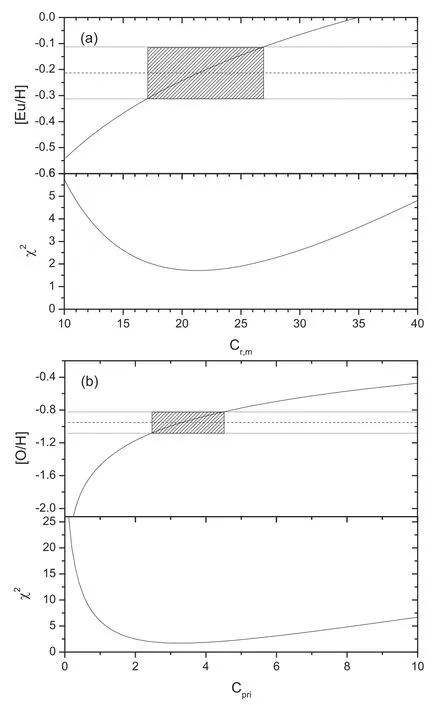
Figure 5.(a)Variation of the calculated abundance ratio[Eu/H](upper panel)and χ2 (lower panel) as a function of Cr,m.(b) Variation of the calculated abundance ratio[O/H](upper panel)and χ2(lower panel)as a function of Cpri.The calculated results are shown with solid lines.The observed values and the observed uncertainties are shown as dashed lines and dotted lines respectively.The shaded regions present the allowed ranges of the component coefficients Cr,m and Cpri.
4.1.Comparison of the Abundance Patterns between HD 222925 and Two Typical r-II Stars
The star CS 22892-052 is a typical r-II star in the Milky Way halo, and the star J033457-540531 ([Fe/H]=−2.08) is a moderately metal-poor r-II star in the ultra-faint dwarf galaxy Ret II with [Eu/H]=−0.31 (Ji et al.2016).We compare the abundance pattern of HD 222925 with that of CS 22892-052 and J033457-540531 (see Figure 6).The element abundances of two stars have been normalized to the Eu abundance of HD 222925, respectively.
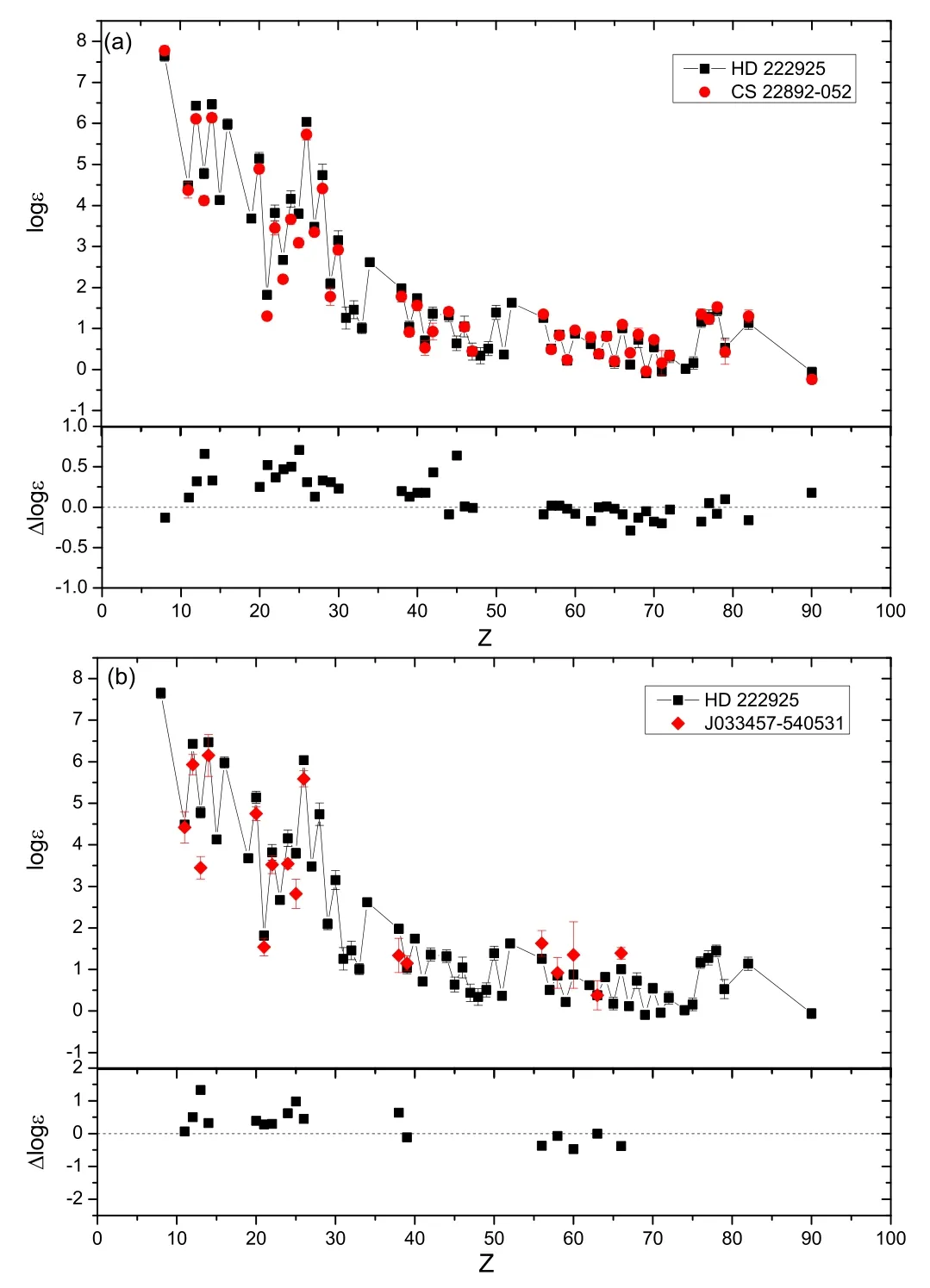
Figure 6.Top panel: comparison of the elemental pattern of HD 222925 against the abundance patterns of CS22892-052 and J033457-540531.The observed abundances of the sample stars are shown as black rectangles, while those of CS22892-052 and J033457-540531 are shown as red circles and diamonds, respectively.Bottom panel: the relative offsets (△ logε=log εHD 222925 -log εCS22892 -052 or J 033457 -540531).
From Figure 6, the larger deviations are presented for the light element comparison of HD 222925 with CS 22892-052 and J033457-540531, but the deviations among neutroncapture elements with Z>56 are relatively small, which suggests that the main r-process is mostly independent of the environment of the star (Johnson et al.2013).By comparing the observed and theoretical abundances of CS 22892-052,Ramirez-Ruiz et al.(2015) suggested that the r-process elements in this star originate from a single r-process event:NSM.Ji et al.(2016) noted that Ret II had undergone a single rare r-process event that had resulted in a 2–3 magnitude higher abundance of heavy neutron-capture elements in r-II stars in this galaxy than in other ultra-faint dwarf galaxies, and they speculated that this single r-process event is an NSM.Considering the fact that the Eu abundance ([Eu/H]=−0.14) of HD 222925 is much higher than those of CS 22892-052 and J033457-540531, we infer that this star was affected by a single, high-yield r-process.Roederer et al.(2018)explained the observed[Eu/H]ratio of HD 222925 due to the r-process material ejected by an NSM.We therefore speculate that the r-process event affecting HD222925 is most likely to be an NSM.
Combined with the analysis in Section 3, we hypothesize that HD 222925 is likely to be first contaminated by a Type II supernova with the progenitor mass M>10M⊙, which increased its Fe abundance, and then by a high-yield NSM,which enriched the r-process elements.Our view is consistent with that of Roederer et al.(2018, 2022).
4.2.Explanation of the Observed Abundance of Eu in HD 222925
Komiya & Shigeyama (2016) indicated that the mass of an NSM ejecting Eu is about 1.5×10−4M⊙and the mass of the cloud contaminated by a single main r-process is about 107M⊙based on the study of the[r/Fe]scatter of metal-poor stars.We assume that the environment in which HD 222925 was born is consistent with the conclusion of Komiya&Shigeyama(2016),and using the method of calculation in Yang et al.(2017), the Eu abundance of HD 222925 can be calculated according to the following equation:
where MSWis the mass of the cloud where the star was born.XEuand XFeare the initial mass fractions of Eu and Fe in the cloud.YEuis the mass of Eu elements ejected by the main rprocess event.AEuand AFeare the atomic weights of Eu and Fe,respectively.The mean value of [Eu/Fe] in Cescutti et al.(2006) is used as the initial Eu abundance of the cloud.We adopt the data in Komiya & Shigeyama (2016), then the calculated Eu abundance of HD 222925 is about 0.60,which is not consistent with the observed Eu abundance ([Eu/Fe]=1.32).There are three possible scenarios that cause the calculated Eu abundance of HD 222925 to be much lower than the observed abundance, and they are as follows: (1) If HD 222925 was born in a cloud of mass 107M⊙,then the yield of Eu ejected by an NSM should be larger than 1.5×10−4M⊙.(2) If the yield of Eu ejected by the NSM is 1.5×10−4M⊙,then the mass of the contaminated cloud should be less than 107M⊙.(3) Both the yield of Eu ejected by an NSM and the mass of the cloud where HD 222925 was born differ from the results in Komiya & Shigeyama (2016).
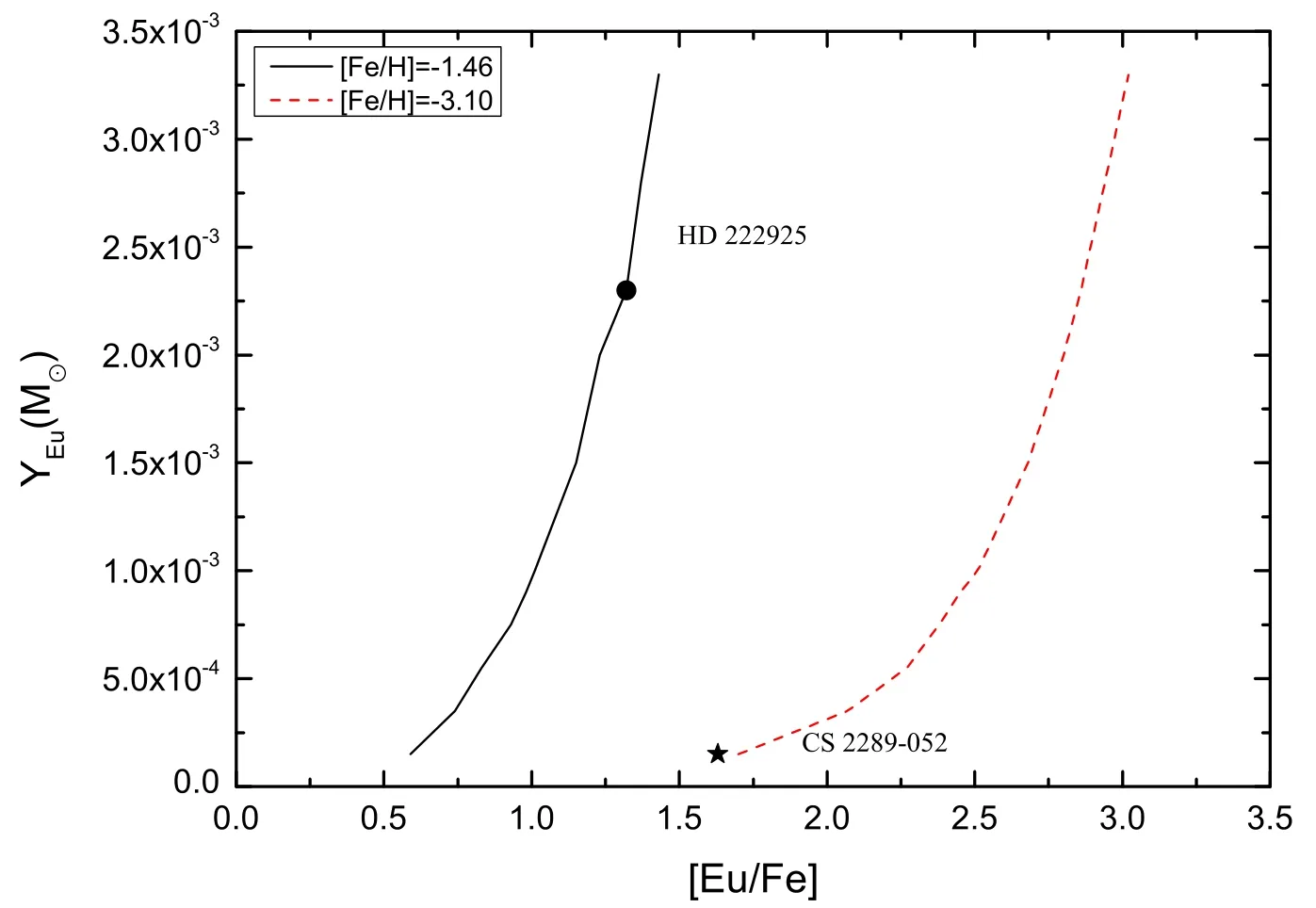
Figure 7.The trend of the yield of Eu ejected by an NSM with[Eu/Fe]for a cloud mass of 107M⊙and metal abundances of–1.46(black solid line)and–3.10(red dashed line).HD 222925 and CS 22892-052 are marked with a dot and a pentagram, respectively.
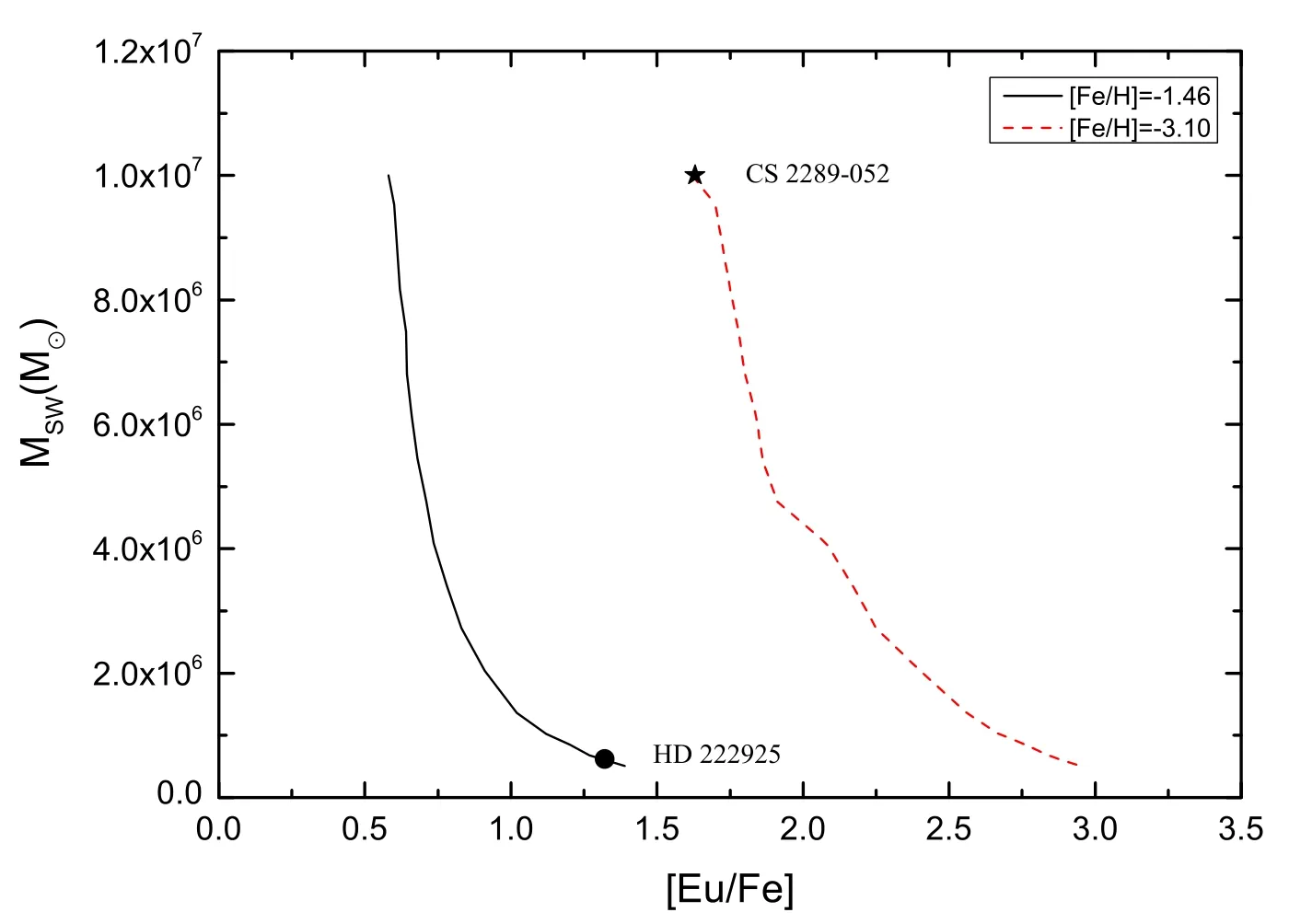
Figure 8.The trend of the cloud mass with [Eu/Fe] for the yield of Eu ejected by an NSM of 1.5×10−4M⊙and metal abundances of –1.46 (black solid line) and–3.10 (red dashed line).HD 222925 and CS 22892-052 are marked with a dot and a pentagram, respectively.
To be able to interpret the observed abundance of Eu in HD 222925, we discuss the following three scenarios.As a comparison, CS 22892-052 also is discussed accordingly and the results of the calculations are also shown in the figure.The first scenario is as follows: (1) Fixing the cloud mass (107M⊙)and stellar metal abundances([Fe/H]=−1.46 and −3.10]),the variation of the yield of Eu ejected by an NSM with Eu abundance is discussed (see Figure 7).It is found in Figure 7 that the required yield of Eu ejected by an NSM increases rapidly as the Eu abundance increases at a fixed cloud mass and at two metal abundances.For [Fe/H]=−1.46, when the yield of Eu ejected by an NSM is 0.0023 M⊙, the Eu abundance is about 1.32,which is consistent with the observed abundance of HD 222925.It means that if HD 222925 was born in a cloud of mass 107M⊙, then an Eu yield of 0.0023 M⊙is sufficient to achieve the observed abundance of Eu in HD 222925.

Figure 9.Variation of the Eu yield from an NSM with the cloud mass for fixed metal and Eu abundances.[Fe/H]=−1.46 and[Fe/H]=−3.10 correspond to the black solid line and the dashed red line, respectively.
The second scenario is as follows:(2)Fixing the yield of Eu ejected by an NSM (1.5×10−4M⊙) and stellar metal abundances([Fe/H]=−1.46 and −3.10), the variation of the cloud mass with Eu abundance is discussed(see Figure 8).We can see that the cloud mass decreases rapidly with increasing Eu abundance at a fixed yield of Eu and at two metal abundances.For[Fe/H]=−1.46,if HD 222925 was born in a cloud of mass 6.2×105M⊙,then its observed abundance of Eu can be explained.
The third scenario is as follows: (3) Fixing stellar metal abundances([Fe/H]=−1.46 and −3.10) and Eu abundances([Eu/Fe]=1.32 and 1.63), the relationship between the cloud mass and the yield of Eu ejected by an NSM is discussed (see Figure 9).As can be seen from Figure 9,the Eu yield increases linearly with increasing the cloud mass for both abundance cases,which is consistent with equations(5).However,we note that for [Fe/H]=−1.46, the Eu yield increases rapidly with increasing the cloud mass, while for [Fe/H]=−3.10, the Eu yield increases more slowly, which is mainly due to the different metal abundances.
5.Conclusion
The r-II stars can provide us with useful information to investigate the astrophysical origin and the yield of the rprocess, and so on.In this paper, we use the five component model to study the elemental abundances and explore the possible astrophysical origins of the elements in the r-II star HD 222925.In addition, adopting the conclusions of Komiya&Shigeyama(2016)and the method of Yang et al.(2017),we investigate the relationship between the mass of the molecular cloud where HD 222925 was born and the yield of Eu ejected by an NSM.We conclude the following points:

(2) The light elements and the iron group elements in HD 222925 are mainly from the primary process of Type II supernova with a progenitor mass M>10M⊙.A fraction of the light neutron-capture elements (31 ≤Z ≤52) in HD 222925 originates from weak r-process, while another fraction originates from main r-process, and the contribution of main r-process increases linearly with increasing atomic number,which is consistent with the conclusions of Li et al.(2013).The heavy neutron-capture elements (Z ≥38) in HD 222925 dominantly come from the main r-process.
(3) We deduce that HD 222925 is likely to be contaminated by an NSM, which causes a significant enhancement of Eu in HD 222925.We find that if HD 222925 was born in a molecular cloud of mass 107M⊙, the Eu yield of 0.0023M⊙ejected by an NSM is sufficient to achieve the observed abundance of Eu in HD 222925.In the other case, if the yield of Eu ejected by an NSM is 1.5×10−4M⊙, the observed abundance of Eu in HD 222925 can be interpreted for a molecular cloud with a mass of 6.2×105M⊙.Our opinions are in agreement with those of Roederer et al.(2018, 2022).
Acknowledgments
This work was supported by the National Natural Science Foundation of China (NSFC) under grants 12 173 013,11 773 009, the National Key Basic R&D Program of China via 2019YFA0405500.W.Y.C.is supported by the“333 talents project” of Hebei Province under the number A202010001.This work is also supported by the Natural Science Foundation of Hebei Province under grant A2021205006,by the project of the Hebei provincial department of science and technology under grant number 226Z7604G, and by Scientific Research Project of Hebei Province (ZC2022090) and Shijiazhuang University Doctoral Scientific Research Fund Project(21BS014).
 Research in Astronomy and Astrophysics2023年12期
Research in Astronomy and Astrophysics2023年12期
- Research in Astronomy and Astrophysics的其它文章
- Large-scale Dynamics of Line-driven Winds with the Re-radiation Effect
- Preliminary Study of Photometric Redshifts Based on the Wide Field Survey Telescope
- Solar Observation with the Fourier Transform Spectrometer.II.Preliminary Results of Solar Spectrum near the CO 4.66μm and MgI 12.32μm
- Density Functional Theory Calculations on the Interstellar Formation of Biomolecules
- Detection Capability Evaluation of Lunar Mineralogical Spectrometer:Results from Ground Experimental Data
- A Comparison of Co-temporal Vector Magnetograms Obtained with HMI/SDO and SP/Hinode
